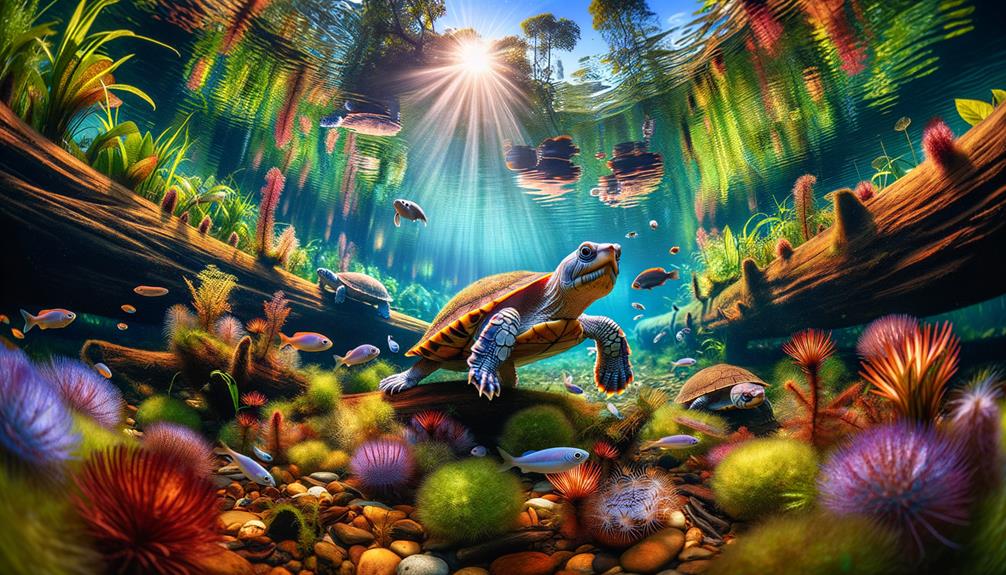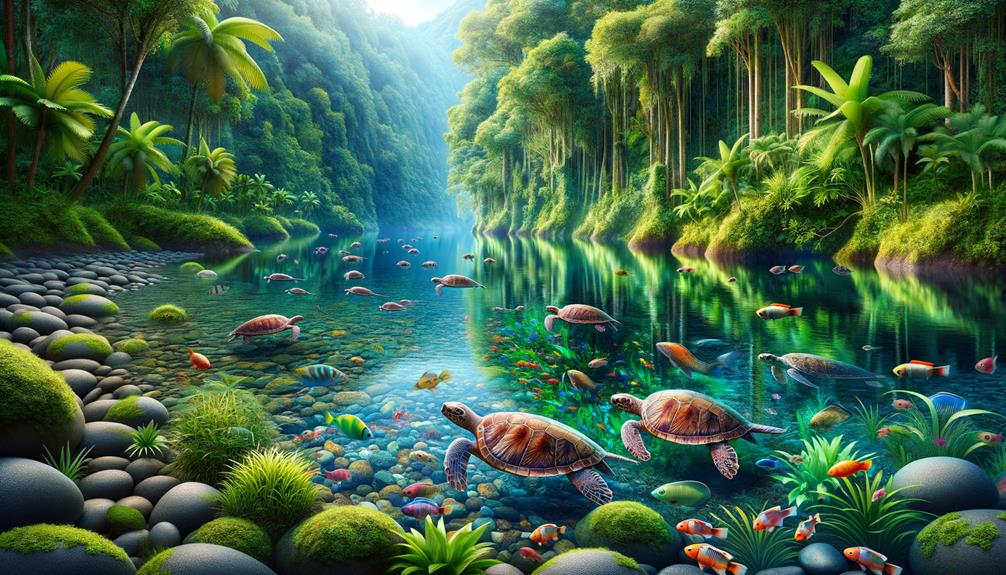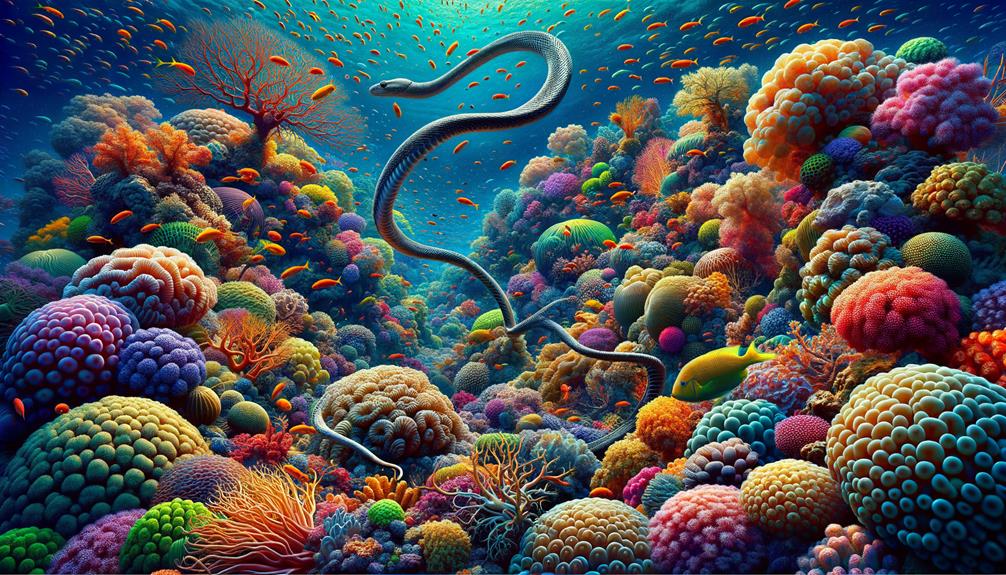Pig-nosed turtles, native to New Guinea's rivers, stand out among freshwater turtles. They're the only ones sporting flippers akin to their sea-dwelling cousins. These odd-looking creatures catch the eye with their fleshy snouts and olive-green shells. They can grow up to 22 inches long and tip the scales at around 50 pounds.
These turtles play a key role in their habitat. They munch on a varied menu of fruits, leaves, and small water critters. But what really sets them apart are the unique challenges they face in the wild.
Their survival hangs in the balance due to specific threats in their home turf. Understanding these risks is crucial for anyone interested in wildlife conservation. Let's take a closer look at what's putting these distinctive turtles in harm's way.
The issues facing pig-nosed turtles aren't just run-of-the-mill environmental concerns. They're dealing with problems tailored to their specific lifestyle and habitat. By examining these threats, we can better grasp the complexities of protecting this one-of-a-kind species.
Physical Characteristics
In New Guinea's rivers, pig-nosed turtles stand out with their unusual features. These creatures sport flippers akin to sea turtles and a fleshy snout for breathing. They can reach lengths of 22 inches and tip the scales at 50 pounds, cutting an impressive figure. Their shells and limbs, ranging from gray to olive green, blend perfectly with their river homes.
Male and female pig-nosed turtles have a key difference: males have longer tails. This trait helps researchers tell them apart in the wild. Their flippers make them swift swimmers, well-suited to New Guinea's varied waterways.
The turtles' snouts aren't just for show. This clever adaptation lets them breathe while mostly submerged, surfacing only briefly for air. Watching these turtles in action, you can't help but admire how well-suited they are to life in New Guinea's rivers.
Their unique traits highlight the wonders of evolution, showcasing how animals adapt to thrive in specific environments. These turtles offer a fascinating glimpse into the diversity of river life in New Guinea, and their distinctive features continue to intrigue scientists and nature enthusiasts alike.
Habitat Preferences

Pig-nosed turtles have a strong affinity for New Guinea's freshwater environments, including rivers, lagoons, and streams. They're particularly fond of waterways with sandy or gravel bottoms, which serve as prime spots for food-hunting and egg-laying. The tree-lined banks offer shelter from potential threats, creating an ideal balance of safety and sustenance.
These adaptable creatures aren't limited to rivers, though. They also flourish in estuaries, lakes, and swamps across New Guinea. This range of habitats allows them to move between water and land with ease. Estuaries, where fresh and salt water mix, provide unique feeding opportunities and refuge. Lakes and swamps offer calmer waters, a stark contrast to the swift-flowing rivers.
The pig-nosed turtle's ability to thrive in various freshwater settings speaks to its resilience. From fast-moving rivers to placid swamps, these turtles have adapted to New Guinea's complex ecosystems. Their versatility underscores the need to protect these diverse habitats.
Feeding Habits

Pig-nosed turtles in New Guinea rivers have a varied diet. They munch on fruits, leaves, crustaceans, mollusks, and insects. These adaptable eaters change their feeding habits based on what's available. By looking at what they eat and how they find food, we get a good picture of their role in the ecosystem and what they prefer to eat.
Scientists studying these turtles have noticed they don't stick to a fixed menu. Instead, they're flexible, adjusting their eating patterns to match the food sources around them. This adaptability helps them thrive in their river habitats.
Understanding the pig-nosed turtle's diet does more than satisfy curiosity. It provides key information about how these creatures fit into their environment. Their food choices affect other species and the overall health of the river ecosystem.
Researchers continue to watch these turtles closely, tracking changes in their diet over time. This ongoing work helps conservationists and wildlife managers make informed decisions about protecting these unique animals and their habitats.
Diet Composition
Pig-nosed turtles in New Guinea rivers eat a bit of everything. Their menu includes fruits and leaves, along with crustaceans, mollusks, and insects. These adaptable creatures make the most of what's available in their watery home.
Their eating habits play a key role in the river ecosystem. By munching on both plants and animals, these turtles help spread nutrients around and keep the food chain balanced. It's not just about filling their own bellies – their diet choices help keep the whole river system healthy.
Let's break down what's on their plate:
| Food Source | Examples |
|---|---|
| Plant Matter | Fruits, Leaves |
| Animal Prey | Crustaceans |
| Mollusks, Insects |
Knowing what pig-nosed turtles eat is crucial for protecting them. We need to make sure their habitats stay intact and their food sources remain plentiful. This knowledge gives us the tools to safeguard these unique creatures and the delicate river ecosystems they call home.
Feeding Frequency
Let's talk about how often pig-nosed turtles in New Guinea rivers eat. These unique creatures have a diverse menu and adapt their eating habits to what's available in their freshwater homes. They're not picky eaters by any means.
Pig-nosed turtles don't follow a strict feeding schedule. Instead, they're always on the lookout for a snack, munching on plants, fruits, small crustaceans, mollusks, and insects. This adaptability is key to their survival and plays a big role in maintaining the river ecosystem's balance.
When certain foods are plentiful, these turtles adjust accordingly. For example, during fig season, you might catch them gorging on these sweet treats. But when aquatic insects or small fish are abundant, they'll switch gears and focus on these protein-rich options.
Their flexible diet allows them to thrive in changing environments, making the most of whatever food sources are available at any given time. This behavior showcases their resilience and highlights their importance in the complex web of New Guinea's river ecosystems.
Foraging Behavior
Pig-nosed turtles in New Guinea's rivers show off some pretty impressive food-finding skills. They're not picky eaters, munching on both plants and animals as they scour sandy banks, underwater plants, and shallow spots for their next meal. These turtles chow down on everything from figs and flowers to tiny crustaceans and bugs, making the most of what their freshwater homes have to offer. By eating such a wide variety of foods, they play a key role in keeping their ecosystem in check.
Let's break down what's on the menu for these turtles:
| Food Source | Examples |
|---|---|
| Plant Matter | Figs, Flowers |
| Animal Sources | Crustaceans, Mollusks |
| Insects | Aquatic Insects |
| Freshwater Plants | Underwater Vegetation |
| Small Aquatic Animals | Fish, Larvae |
This varied diet shows just how adaptable these turtles are. They're not just surviving in their river homes – they're thriving. By eating such a mix of foods, they're helping to keep populations of various plants and animals in balance. It's a perfect example of how one species can have a big impact on its surroundings.
Reproductive Behavior

From September to January, pig-nosed turtles in New Guinea's rivers take part in a complex mating ritual. Both males and females pair up with multiple partners, boosting genetic variety and upping the odds of successful breeding.
Their eggs take between 65 and 107 days to hatch. When they do, the baby turtles are ready to go, needing no help from their parents to tackle life in the water.
But these turtles face some tough challenges when it comes to having babies:
- People are wrecking their nesting spots.
- Poachers steal eggs and grown turtles for pets or food.
- Changes to rivers mess up their breeding grounds.
These issues make it hard for the turtles to have enough babies to keep their numbers up. The damage to their homes and the theft of eggs and adults are especially bad news, directly cutting down on successful nests and hatchlings.
To give these unique reptiles a fighting chance, we need to protect where they live and crack down on illegal hunting. It's a race against time as humans push further into turtle territory.
Geographic Distribution

Pig-nosed turtles call the waterways of southern New Guinea home. These unique creatures thrive in the warm, fresh waters of rivers, estuaries, and lagoons, preferring sandy or gravelly bottoms. Their natural habitat spans a variety of aquatic environments, each playing a crucial role in their survival. By studying the specific river systems and regions where these turtles live, researchers gain valuable information about their environmental needs. This knowledge is key to developing effective conservation strategies for these fascinating reptiles. Understanding their geographic range not only sheds light on their current status but also helps predict how changes in their habitat might affect their future.
Native Habitat Range
These odd-looking turtles call the freshwater rivers and wetlands of New Guinea, southern Irian Jaya, and northern Australia home. They prefer areas with sandy and gravelly bottoms, which are perfect for their lifestyle and breeding. Key waterways like the Fly River and Daly River in New Guinea play a crucial role in their survival.
Pig-nosed turtles flourish in spots featuring:
- Sandy and gravelly riverbeds: These are vital for nesting and finding food.
- Thick forest along the banks: Offering shade and cover.
- Freshwater ecosystems: Including rivers, estuaries, lagoons, lakes, swamps, and pools.
Protecting these unique turtles is becoming more urgent. Human activities such as cutting down forests, polluting waters, and destroying habitats pose significant risks. By focusing on preserving their natural environments, especially the river systems in New Guinea and northern Australia, we can help ensure these turtles stick around for future generations.
River Systems Inhabitance
Pig-nosed turtles make their home in New Guinea's complex river networks, particularly favouring the diverse freshwater environments of the Fly and Daly Rivers. These unique creatures don't limit themselves to main waterways; they also populate estuaries and lagoons in southern Irian Jaya and New Guinea. The sandy and gravelly river bottoms suit them perfectly, allowing easy movement and foraging.
These turtles show impressive flexibility in their habitat choices. Thick forest along the riverbanks offers shelter and resources, supporting their feeding and nesting needs. The Fly and Daly Rivers create a vibrant setting where these turtles flourish. The connected waterways let them roam freely, ensuring they can access food and nesting spots.
These freshwater ecosystems are crucial for pig-nosed turtles. They munch on various water plants and small critters that thrive in these rich habitats. Come nesting time, they often use the sandy banks, underscoring how vital these river systems are to their survival. Simply put, New Guinea's rivers are the beating heart of these intriguing freshwater turtles' existence.
Environmental Preferences
Pig-nosed turtles make their home in the diverse freshwater habitats of southern New Guinea. These adaptable creatures thrive in rivers, estuaries, lagoons, lakes, and swamps, showcasing their versatility across various ecosystems.
You'll often spot these turtles in waterways with sandy and gravelly bottoms, which suit their feeding and nesting habits perfectly. The rivers they call home, like those in the Fly River area and the Daly River, typically have densely wooded banks. This lush vegetation provides shade and protection, playing a key role in the turtles' survival and well-being.
Key habitats include:
- Rivers with sandy and gravelly beds
- Areas with thick forest cover along the banks
- A mix of environments from lakes to swamps
These turtles are found throughout southern New Guinea, highlighting their toughness and ability to adapt. Whether in still lagoon waters or fast-flowing rivers, they flourish in a range of freshwater settings. Each habitat they occupy supports their unique lifestyle, allowing them to thrive despite environmental challenges. Their presence in these varied locations underlines their crucial role in maintaining the balance of New Guinea's freshwater ecosystems.
Conservation Status

The pig-nosed turtle's future in New Guinea rivers looks grim. These unique creatures, now listed as Endangered, face a steep drop in numbers. The International Union for Conservation of Nature (IUCN) points to several reasons for this decline. Damaged habitats and poaching for the pet market stand out as key threats. Once-thriving populations in New Guinea's waterways now struggle to survive.
Quick action is needed to turn this situation around. Deforestation and pollution have ravaged the turtles' natural homes, making it tough for them to thrive. The problem worsens as poachers snatch these turtles from the wild, disrupting their ability to reproduce.
Conservationists are racing against time to protect these distinctive reptiles. They're pushing for stronger laws against poaching and working with local communities to safeguard turtle habitats. Some groups are even setting up breeding programs to boost turtle numbers.
But challenges remain. Climate change poses a new threat, potentially altering the rivers these turtles call home. Plus, educating people about the turtles' plight and changing long-standing practices takes time.
Despite the hurdles, there's hope. With continued efforts and public support, we might just see these remarkable creatures bounce back from the brink.
Threats and Challenges

Pig-nosed turtles in New Guinea face serious problems. Poachers snatch them up for the pet market, while loggers and miners wreck their homes. These activities are hitting turtle numbers hard.
The turtles' living spaces are taking a beating. When loggers strip trees from riverbanks, they destroy crucial nesting spots. Miners pollute the water, making it unlivable. To make matters worse, water buffalo stomp on turtle nests and mess up the delicate balance of river life.
Turtle populations are dropping fast. The IUCN Red List now calls them Endangered. Despite efforts to protect them, these turtles are still in hot water. Stopping poaching and habitat destruction is key to keeping them around.
Here's what's hurting pig-nosed turtles:
- Poaching for pets: Seriously cuts down their numbers.
- Logging and mining: Ruins their homes, making survival tough.
- Water buffalo: Wreck nesting areas, adding to the population drop.
To give pig-nosed turtles a fighting chance, we need to step up our game and tackle these issues head-on.
Interesting Facts

Pig-nosed turtles in New Guinea's waterways have evolved some pretty cool features, especially their snouts. These critters, which you'll spot in rivers, estuaries, and lagoons across southern New Guinea, stand out from the crowd. Their snouts aren't just for show – they're key for finding food and breathing underwater.
These turtles are hefty characters, growing up to 22 inches long and tipping the scales at 50 pounds. They're not picky eaters, chomping on both plants and animals, though they lean towards greens. This flexibility in diet helps them thrive in different spots. Their flippers, which look a lot like sea turtle flippers, let them zip through the water with ease.
But life's not all smooth sailing for these turtles. They're facing tough times due to habitat loss and people exploiting them. Conservationists are working hard to keep their numbers up as the situation gets more dire. By getting to know these unique creatures and their role in the ecosystem, we can better protect these fascinating residents of New Guinea's rivers.
Frequently Asked Questions
Where Are Pig-Nosed Turtles Found?
Pig-nosed turtles make their home in a variety of freshwater settings. You'll find them swimming in rivers, hanging out in estuaries, and lounging in lagoons. These unique creatures seem to prefer spots with sandy or gravelly bottoms, often surrounded by thick forest along the banks. They're particularly abundant in the southern parts of Irian Jaya and New Guinea. If you're hoping to spot one of these peculiar-looking turtles, those are the areas to keep an eye on. Their distinctive snouts make them stand out among other turtle species in these regions.
What Temperature Should the Water Be for a Pig-Nosed Turtle?
Pig-nosed turtles thrive best when their water stays between 79°F and 86°F. This range mirrors their natural habitat, helping these unique reptiles stay healthy and relaxed. Keeping an eye on the temperature and adjusting it as needed prevents unnecessary stress on the turtles. By maintaining these conditions, turtle owners create a comfortable environment that supports their pets' well-being.
Why Are Pig-Nosed Turtles Important?
Pig-nosed turtles play a crucial role in their habitats. These unique creatures act as both hunters and hunted, helping maintain the delicate balance of their ecosystem. Scientists pay close attention to these turtles, as their well-being often reflects the overall health of their environment. By studying pig-nosed turtles, researchers gain valuable insights into ecological dynamics. The turtles' status also highlights the ongoing need for wildlife protection efforts in their native regions.
Can Pig-Nosed Turtles Be Pets?
Pig-nosed turtles aren't suitable as pets. These unique creatures face serious conservation challenges and require specialized care that's hard to replicate in captivity. Their complex needs include specific habitats and diets, making them ill-suited for domestic environments. Keeping these turtles at home often contributes to their declining numbers in the wild. Instead of trying to domesticate them, we should focus on preserving their natural habitats. The best way to appreciate these fascinating animals is by supporting conservation efforts that protect their freedom in their native ecosystems.



